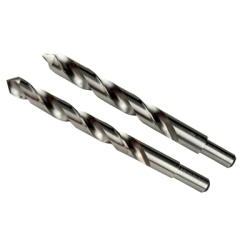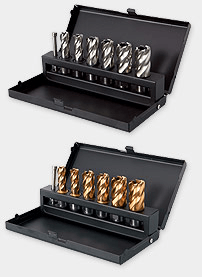Drill Bits Information

Drills and drill bits are used in many industrial applications for machining of metals, plastics, and other materials, construction, woodworking, and specialty applications and crafts such as gemology and medical surgery. Many of the cutting edge features and specifications are application-dependent, as are the optimal feed rates and cutting speeds. Cutting applications for drill bits include general-purpose, aluminum, brass, bronze, and copper, ceramic, hard or hardened materials, plastic, steel, stainless steel, titanium and other exotic materials, and wood.
Sizes
Drill bits can be supplied in one of four standard size units. These include English or fractional, metric, wire gauge, and letter size. An English drill bit is designed with base units of inches or fractions of an inch. A metric drill bit is designed with metric base units such as millimeters or centimeters. A wire gauge drill bit is designed in standard wire gauge sizes, designated 1 to 80. A letter size drill bit is designed in standard letter designation sizes from A to Z. The full tool-cutting diameter is an important specification when considering drill bits.
Types
Drill bits are available for different drill types. These include standard or twist drills, jobber length drills, taper length drills, extension or extra length drills, screw machine drills, spotting drills, center drills, microdrills, gundrills, core drills, spade drills, step drills, silver and Deming drills, forstner drills, taper drills, high helix drills, masonry drills, surgical or dental drills, hole saw, wood bit, combination drill and countersink, combination drill and counter bore, combination drill and tap, and drill blank.
Drill Bit Design and Construction
Rotation on drill bits can be either right hand or left hand. Right hand drill bits are the most common. They are designed to cut while turning clockwise. Left hand drill bits are designed to cut while turning counterclockwise. Drill bits may have NAS specifications stating that they are manufactured in accordance with National Aerospace Standards (NAS). Some drill bits are coolant fed; they have a hole or channel for directed coolant feed at or near the cutting edges. Split point drill heads are used for chip clearance and for good centering, avoiding "walking" on the workpiece on initial contact.
 Drill bits can be of solid construction or a holder and inserts. A solid construction drill is manufactured from a solid piece of material. In a holder and inserts construction, the drill is constructed with a holder with attachable inserts. These inserts typically bolt onto the holder are replaceable when the cutting edges are worn. Common materials of construction include high-speed steel, cobalt, carbide, and diamond PCD. Drill bits may be coated to assist in cutting lubricity and/or add abrasion resistance for longer tool life. Shank types include straight, tapered, reduced, hex, square, and threaded.
Drill bits can be of solid construction or a holder and inserts. A solid construction drill is manufactured from a solid piece of material. In a holder and inserts construction, the drill is constructed with a holder with attachable inserts. These inserts typically bolt onto the holder are replaceable when the cutting edges are worn. Common materials of construction include high-speed steel, cobalt, carbide, and diamond PCD. Drill bits may be coated to assist in cutting lubricity and/or add abrasion resistance for longer tool life. Shank types include straight, tapered, reduced, hex, square, and threaded.
Standards
The following are industry and government standards pertaining to drill bits:
GOST 26474 - Diamond and Extra-Hard Composite Material Drill Bits and Core Bits. Types and Main Dimensions.
BS ISO 9714-1 - Orthopaedic Drilling Instruments Part 1: Drill Bits, Taps and Countersink Cutters.
BS ISO 5468 - Rotary and Rotary Impact Masonry Drill Bits with Hardmetal Tips -- Dimensions.
Image credits:
- Alabama
- Arkansas
- Arizona
- California
- Colorado
- Connecticut
- Florida
- Georgia
- Iowa
- Idaho
- Illinois
- Indiana
- Kansas
- Kentucky
- Louisiana
- Massachusetts
- Maryland
- Michigan
- Minnesota
- Missouri
- Montana
- North Carolina
- Nebraska
- New Hampshire
- New Jersey
- New Mexico
- Nevada
- New York
- Ohio
- Oklahoma
- Oregon
- Pennsylvania
- Rhode Island
- South Carolina
- Tennessee
- Texas
- Utah
- Virginia
- Vermont
- Washington
- Wisconsin
- West Virginia
- Aluminum
- Bronze / Brass / Copper
- Carbide
- Center Drill
- Coated
- Cobalt
- Combination Drill / Countersink
- Combination Drill / Tap
- Coolant Feed
- Core Bit
- Diamond / PCD
- Drill Blank
- Drill Set
- English / Fractional
- Extension / Extra Length
- Forstner Drill Bit
- General Purpose
- Gundrill
- Hard / Hardened Metals
- Hex Shank
- High Speed Steel
- Holder and Inserts
- Hole Saw
- Individual Drill
- Jobber Length Drill
- Left Hand
- Letter Size
- Masonry Drill Bit
- Metric
- Microdrill
- Coating / Finish: None
- Plastic
- Reduced Shank
- Right Hand
- Screw Machine Drill
- Silver & Deming Drill
- Solid Construction
- Spade Drill
- Split Point
- Spotting Drill
- Square Shank
- Stainless Steel
- Standard / Twist Drill
- Steel
- Step Drill
- Straight Shank
- Surgical / Dental Drill
- Taper Drill
- Taper Length Drill
- Tapered Shank
- Threaded Shank
- Titanium / Exotic Metals
- Wire Gauge
- Wood
- Wood Bit
- rock drill bits
- drill bits for metal
- micro drill bits
- orifice drill bits
- circuit board drill bits
- #15 aircraft length drill bits
- #3 morse taper drill bits
- 0.040 drill bits
- 0.8mm drill bits
- 1.2mm drill bits
- 1.5 inch drill bits
- 10 long drill bits
- 100 mm core drill bits
- 127mm core drill bits
- 13.5mm drill bits
- 16mm masonry drill bits
- 2 core drill bits
- 2 flute drill bits
- 2 spade drill bits
- 3 inch spade drill bits
- 32mm drill bits
- 35mm drill bits
- 4 flute drill bits
- 5mm drill bits
- 7mm drill bits
- brass drill bits
- carbide left hand drill bits
- carbide metric drill bits
- cement board drill bits
- center drill bits
